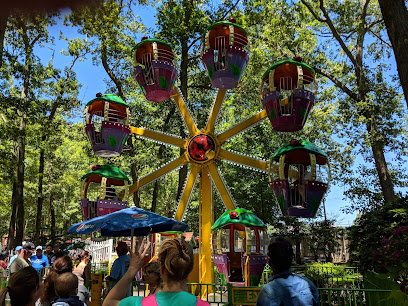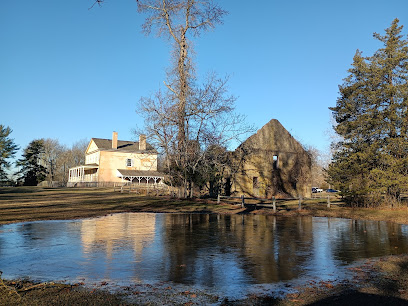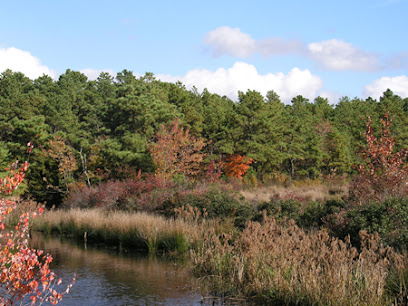
The Enigmatic Pine Barrens of New Jersey
Discover the Pine Barrens of New Jersey, an expansive wilderness brimming with unique ecology, rich history, and captivating legends, perfect for nature lovers and adventure seekers.
Welcome to the Pine Barrens, a vast and mysterious wilderness in Southern New Jersey. Known for its unique ecology and rich history, the Pine Barrens cover over one million acres of dense forests, winding rivers, and sprawling wetlands. This region is a sanctuary for nature enthusiasts, offering an escape into one of the most unique ecosystems on the East Coast. The Pine Barrens are home to a diverse array of flora and fauna, including rare orchids, carnivorous plants, and an abundance of wildlife such as deer, foxes, and over 200 species of birds. It’s also famous for its pitch pine forests that give the area its name. Hiking and kayaking are popular activities, with numerous trails and waterways to explore, each offering a chance to immerse yourself in the tranquility of the natural surroundings. Beyond its natural beauty, the Pine Barrens hold a treasure trove of folklore and history. The area is steeped in legends, the most famous being the tale of the Jersey Devil, a mythical creature said to inhabit the woods. Historical sites such as Batsto Village provide a glimpse into the region’s colonial past, with preserved buildings and artifacts from the 18th and 19th centuries. Whether you’re drawn by the legends or the landscapes, the Pine Barrens offer a distinctive and memorable experience for all visitors.
Local tips in Pine Barrens
- Wear appropriate footwear for hiking, as some trails can be sandy and uneven.
- Bring insect repellent, especially in the warmer months, to protect against ticks and mosquitoes.
- Visit Batsto Village for a historical perspective on the area and to see well-preserved colonial-era buildings.
- Check local regulations if you plan to kayak or canoe, as some waterways may have restrictions.
- Keep an eye out for local wildlife, but remember to maintain a safe distance and respect their habitats.
The Enigmatic Pine Barrens of New Jersey
Welcome to the Pine Barrens, a vast and mysterious wilderness in Southern New Jersey. Known for its unique ecology and rich history, the Pine Barrens cover over one million acres of dense forests, winding rivers, and sprawling wetlands. This region is a sanctuary for nature enthusiasts, offering an escape into one of the most unique ecosystems on the East Coast. The Pine Barrens are home to a diverse array of flora and fauna, including rare orchids, carnivorous plants, and an abundance of wildlife such as deer, foxes, and over 200 species of birds. It’s also famous for its pitch pine forests that give the area its name. Hiking and kayaking are popular activities, with numerous trails and waterways to explore, each offering a chance to immerse yourself in the tranquility of the natural surroundings. Beyond its natural beauty, the Pine Barrens hold a treasure trove of folklore and history. The area is steeped in legends, the most famous being the tale of the Jersey Devil, a mythical creature said to inhabit the woods. Historical sites such as Batsto Village provide a glimpse into the region’s colonial past, with preserved buildings and artifacts from the 18th and 19th centuries. Whether you’re drawn by the legends or the landscapes, the Pine Barrens offer a distinctive and memorable experience for all visitors.
When is the best time to go to Pine Barrens?
Iconic landmarks you can’t miss
Whitesbog Historic Village
Explore the historic charm of Whitesbog Historic Village, where New Jersey's agricultural history comes alive amidst stunning landscapes and delightful local treats.

The Pine Barrens
Explore the Pine Barrens, a breathtaking expanse of New Jersey wilderness filled with mystery, adventure, and diverse ecosystems.

Unmissable attractions to see
Seaside Heights Beach
Experience the sun, surf, and vibrant atmosphere of Seaside Heights Beach, a premier coastal destination in New Jersey perfect for beach lovers.

Storybook Land
Discover the magic of Storybook Land, a captivating amusement park in Egg Harbor Township filled with enchanting rides and beloved fairy tale characters.

Wharton State Forest
Explore the breathtaking landscapes and rich history of Wharton State Forest, a premier destination for outdoor enthusiasts in New Jersey.

Batsto Village
Discover the enchanting Batsto Village, a historic iron-making town nestled in New Jersey's scenic pine barrens, rich in heritage and natural beauty.

Bass River State Forest
Experience the natural beauty and tranquility of Bass River State Forest, a perfect getaway for outdoor enthusiasts in New Jersey.

Double Trouble State Park
Discover the beauty and history of Double Trouble State Park in Bayville, NJ—a perfect getaway for nature lovers and history enthusiasts alike.

Seaside Park Beach & Lifeguard
Discover the beauty and charm of Seaside Park Beach, a perfect coastal escape with golden sands, lively boardwalks, and family-friendly fun in New Jersey.

Whitesbog Historic Village
Experience the rich agricultural heritage and natural beauty of Whitesbog Historic Village, a historic gem in New Jersey's Pine Barrens.

Franklin Parker Preserve — Chatsworth Lake Entrance
Escape to Franklin Parker Preserve, a picturesque nature preserve in New Jersey's Pinelands, ideal for outdoor adventures and serene retreats.

The Pine Barrens
Discover the Pine Barrens: A captivating wilderness of rich biodiversity and legendary folklore in New Jersey's enchanting forests.

Princeton University Store
Discover the spirit of Princeton University at the Princeton University Store, where clothing, gifts, and memories await every visitor.

Atsion Mansion
Explore the captivating history and serene beauty of Atsion Mansion, a hidden gem in New Jersey's Pine Barrens.

New Jersey Pinelands National Reserve
Experience the natural beauty and rich biodiversity of the New Jersey Pinelands National Reserve, a serene escape for nature lovers and adventurers.

Seaside park
Discover the beauty of Seaside Park, a charming beach destination in New Jersey perfect for relaxation, adventure, and coastal fun.

Markets, malls and hidden boutiques
Freehold Raceway Mall
Explore Freehold Raceway Mall: New Jersey's premier shopping and dining destination with a vast array of stores, eateries, and entertainment options.

Moorestown Mall
Explore the vibrant Moorestown Mall in New Jersey for a perfect blend of shopping, dining, and entertainment in a welcoming atmosphere.

Jackson Premium Outlets
Discover unbeatable deals at Jackson Premium Outlets, the ultimate shopping destination in New Jersey with over 70 designer and brand-name stores.

West End Garage
Discover the eclectic charm of West End Garage in Cape May, a vintage marketplace filled with antiques, art, and local crafts.

Surf City 5 and 10
Explore Surf City 5 and 10 for all your beach essentials, souvenirs, and unique finds in beautiful Surf City, New Jersey.

His Place
Explore the finest men's clothing at His Place in Lakewood, NJ – where style meets quality in a welcoming atmosphere.

The Pine Barrens
Discover the Pine Barrens of New Jersey, a stunning forested wilderness rich in history, biodiversity, and outdoor adventures.

The Music Place
Explore The Music Place in West Berlin, NJ - Your ultimate destination for musical instruments, expert advice, and a vibrant community of musicians.

UNIQUE-TOUCHES
Explore UNIQUE-TOUCHES in Hamilton Township, NJ, for unique gifts and local treasures that make perfect souvenirs or heartfelt presents.

His Place Collection
Discover stylish men's clothing and exceptional service at His Place Collection in Lakewood, NJ – your ultimate fashion destination.

New Concept Sports Card and Hobby
Explore a collector's paradise at New Concept Sports Card and Hobby, your go-to destination for sports cards, gaming, and unique memorabilia in Medford, NJ.

The Gallery Collection
Discover unique women's fashion at The Gallery Collection in Lakewood, NJ, where style meets elegance in a welcoming boutique setting.

Card Smart
Explore Card Smart in Clementon, NJ for unique gifts, antiques, and party supplies—perfect for every occasion!

Interwoven
Discover unique clothing, home goods, and gifts at Interwoven in Asbury Park, a must-visit boutique for every traveler.

Deena's
Discover unique gifts, stylish clothing, and fashionable accessories at Deena's in Point Pleasant Beach, NJ – a must-visit for every tourist.

Essential bars & hidden hideouts
The Pub
Experience the best of American cuisine at The Pub in Pennsauken Township, where flavor meets hospitality.

Miller's Ale House
Experience the vibrant ambiance and delectable American cuisine at Miller's Ale House, a must-visit for sports lovers in Woodbridge Township.

Prospector's Steakhouse & Saloon
Experience a delightful blend of hearty American cuisine and vibrant nightlife at Prospector's Steakhouse & Saloon in Mt. Laurel Township.

Vera Bar & Grill
Discover Vera Bar & Grill: A delightful blend of great food, lively atmosphere, and unforgettable events in Cherry Hill, NJ.

Klee's Bar & Grill
Discover the vibrant flavors of Klee's Bar & Grill in Seaside Heights, where American cuisine meets Irish hospitality by the beach.

Element Restaurant & Bar
Discover Element Restaurant & Bar in Stafford Township, a must-visit destination for food lovers seeking a vibrant dining experience with diverse menu options.

Maloney's Pub & Grill
Discover the vibrant atmosphere and delicious food at Maloney's Pub & Grill, a must-visit destination for tourists in Matawan, New Jersey.

Killarney's Publick House
Experience authentic Irish hospitality at Killarney's Publick House, where delicious food and vibrant ambiance come together in Hamilton Township.

The Mainland Kitchen + Pub
Experience the vibrant flavors and welcoming atmosphere of The Mainland Kitchen + Pub in Manahawkin, NJ - a must-visit culinary destination for tourists.

Brass Rail Bar & Grill
Delight your taste buds at Brass Rail Bar & Grill in Matawan, New Jersey, where grilled perfection meets a vibrant bar atmosphere.

Country Club Tavern
Experience a delightful blend of local cuisine and craft beverages at Country Club Tavern, a must-visit bar and restaurant in Cape May Court House.

The Mile Bar
Discover The Mile Bar in Runnemede, where delicious grilled favorites meet a vibrant pub atmosphere for an unforgettable dining experience.

Horseshoe Tavern
Discover the Horseshoe Tavern in Morristown, NJ – a lively bar and restaurant offering American cuisine, sports, and unforgettable nightlife.

Max's Bar & Grill
Experience the vibrant flavors of America at Max's Bar & Grill in Long Branch, NJ - where delicious meals and a lively atmosphere await.

The Edge Restaurant
Experience the perfect blend of a vibrant bar and exquisite dining at The Edge Restaurant in Jackson Township.

Local Phrases about Pine Barrens
-
- HelloHowdy
[haʊdi] - GoodbyeSee ya
[siː jə] - YesYup
[jʌp] - NoNah
[nɑː] - Please/You're welcomePlease
[pliːz] - Thank youThanks
[θæŋks] - Excuse me/SorryPardon
[pɑːrdn] - How are you?How you doin'?
[haʊ jʊ ˈdɔɪn] - Fine. And you?Good. How 'bout you?
[ɡʊd. haʊ ˈbaʊt jʊ] - Do you speak English?Ya speak English?
[jə spiːk ˈɪŋɡlɪʃ] - I don't understandI ain't gettin' ya
[aɪ eɪnt ˈɡɛtɪn jə]
- HelloHowdy
-
- I'd like to see the menu, pleaseI wanna check the menu, please
[aɪ ˈwɑnə ʧɛk ðə ˈmɛnjuː pliːz] - I don't eat meatI don't do meat
[aɪ doʊnt duː mit] - Cheers!Cheers!
[ʧɪrz] - I would like to pay, pleaseI gotta settle up, please
[aɪ ˈɡɑtə ˈsɛtl ʌp pliːz]
- I'd like to see the menu, pleaseI wanna check the menu, please
-
- Help!Help!
[hɛlp] - Go away!Git outta here!
[ɡɪt ˈaʊtə hɪər] - Call the Police!Call the cops!
[kɔl ðə kɒps] - Call a doctor!Call the doc!
[kɔl ðə dɑk] - I'm lostI'm all turned around
[aɪm ɔl tɜrnd əˈraʊnd] - I'm illI'm feelin' under the weather
[aɪm ˈfiːlɪn ˈʌndər ðə ˈwɛðər]
- Help!Help!
-
- I'd like to buy...I'm lookin' to purchase...
[aɪm ˈlʊkɪn tʊ ˈpɜːrʧəs] - I'm just lookingJust browsin'
[ʤʌst ˈbraʊzɪn] - How much is it?How much for that?
[haʊ mʌʧ fɔr ðæt] - That's too expensiveThat's a bit steep
[ðæts ə bɪt stip] - Can you lower the price?Can ya come down in price?
[kæn jə kʌm daʊn ɪn praɪs]
- I'd like to buy...I'm lookin' to purchase...
-
- What time is it?What's the time?
[wɑːts ðə taɪm] - It's one o'clockIt's one
[ɪts wʌn] - Half past (10)Half past ten
[hæf pæst tɛn] - MorningMornin'
[ˈmɔrnɪn] - AfternoonAfternoon
[ˌæftərˈnun] - EveningEvenin'
[ˈivənɪn] - YesterdayYest'day
[ˈjɛstˌdeɪ] - TodayToday
[təˈdeɪ] - TomorrowTomorra
[təˈmɑrə] - 1One
[wʌn] - 2Two
[tuː] - 3Three
[θriː] - 4Four
[fɔːr] - 5Five
[faɪv] - 6Six
[sɪks] - 7Seven
[ˈsɛvən] - 8Eight
[eɪt] - 9Nine
[naɪn] - 10Ten
[tɛn]
- What time is it?What's the time?
-
- Where's a/the...?Where's the...
[wɛərz ðə] - What's the address?What's the addy?
[wɑːts ðə ˈædi] - Can you show me (on the map)?Can ya point it out (on the map)?
[kæn jə pɔɪnt ɪt aʊt ɒn ðə mæp] - When's the next (bus)?When's the next (bus)?
[wɛnz ðə nɛkst bʌs] - A ticket (to ....)A ticket (to ....)
[ə ˈtɪkɪt tuː]
- Where's a/the...?Where's the...
History of Pine Barrens
-
The Pine Barrens, known for its unique ecosystem, was originally inhabited by the Lenape Native Americans. They thrived in this environment, utilizing the rich resources of the forests, rivers, and coastline. The arrival of European settlers in the 17th century brought significant changes to the region. The settlers established small, isolated communities and began exploiting the natural resources, leading to a mixed relationship between the newcomers and the indigenous people.
-
In the 18th and 19th centuries, the Pine Barrens became a hub for the iron and glass industries. The abundant supply of bog iron and wood made it an ideal location for these industries to thrive. Towns like Batsto Village and Atsion flourished during this period, producing iron for tools, weapons, and other goods. The glass industry also took off, with factories taking advantage of the sand found in the area to produce high-quality glass products.
-
Batsto Village is one of the most well-preserved historical sites in the Pine Barrens. Established in 1766, it became a center for iron production during the American Revolutionary War. The village continued to grow and diversify its production into glass and other goods. However, by the late 19th century, the decline of the iron industry led to Batsto's gradual abandonment. Today, it serves as a window into the past, with restored buildings and guided tours telling the story of its rise and fall.
-
One of the most significant events in the Pine Barrens' history was the wildfire of 1930. This devastating fire burned thousands of acres of forest, highlighting the challenges of managing such a vast and wild landscape. The fire prompted changes in forest management practices and increased awareness of the ecological importance of the region. The resilience of the Pine Barrens ecosystem allowed it to recover and continue to serve as a critical habitat for diverse plant and animal species.
-
The Pine Barrens is famously home to the legend of the Jersey Devil, a creature said to inhabit the remote areas of the forest. According to folklore, the Jersey Devil was born to a woman named Mother Leeds in 1735 and has since been a part of local mythology. Sightings and stories of the creature have persisted over centuries, adding an element of mystery and intrigue to the region. The legend continues to attract curious visitors and paranormal enthusiasts to the Pine Barrens.
-
Wharton State Forest, the largest state forest in New Jersey, was officially established in 1954. Named after Joseph Wharton, a businessman who acquired large tracts of land in the Pine Barrens in the 19th century, the forest preserves over 100,000 acres of diverse habitats. It provides opportunities for recreation, conservation, and education, offering visitors a chance to explore the unique landscape and learn about the area's history and ecology.
Pine Barrens Essentials
-
Pine Barrens is located in southern New Jersey, United States. The nearest major airport is Philadelphia International Airport (PHL), approximately 50 miles west of the region. Alternatively, Newark Liberty International Airport (EWR) is about 90 miles to the north. From these airports, you can rent a car or take a shuttle service. If traveling by train, NJ Transit offers connections to nearby towns such as Hammonton and Egg Harbor City, where you can then rent a car or take a local taxi to reach Pine Barrens.
-
While Pine Barrens itself is best explored by car due to its vast and remote nature, there are several options for getting around. Renting a car is highly recommended for the freedom to explore at your own pace. Biking is popular for those looking to explore the trails. Local buses and taxis are available in the surrounding towns, but they may not reach deeper into the wilderness areas. Guided tours are also available for those who prefer a structured visit.
-
The currency used in Pine Barrens and throughout the United States is the US Dollar (USD). Credit and debit cards are widely accepted in most establishments, including hotels, restaurants, and gas stations. However, some smaller, rural establishments may only accept cash. ATMs are available in surrounding towns like Hammonton and Medford, so it is advisable to carry some cash for convenience.
-
Pine Barrens is generally a safe destination for tourists. However, visitors should be cautious when venturing into remote areas. Always inform someone about your plans and expected return time. While there are no specific high-crime areas targeting tourists, it is essential to stay vigilant, especially at night. Lock your vehicles and keep valuables out of sight. Be mindful of wildlife, and avoid feeding or approaching animals.
-
In case of an emergency, dial 911 for immediate assistance. Nearby towns such as Hammonton and Medford have police stations and medical facilities. It is recommended to have travel insurance that covers medical emergencies. For minor health issues, there are pharmacies available in surrounding towns. If you get lost or encounter difficulties while hiking or exploring, contact local park rangers or emergency services.
-
Fashion: Do wear comfortable and weather-appropriate clothing, especially sturdy footwear for hiking. Avoid wearing high heels or open-toed shoes. Religion: Do respect the local customs and traditions, including any religious sites you may encounter. Public Transport: Do be courteous on public transport and give up your seat to elderly passengers. Don’t play loud music or talk loudly on your phone. Greetings: Do greet people with a friendly nod or a simple 'hello.' Eating & Drinking: Do try local cuisine and support local businesses. Don’t leave litter behind, especially in natural areas.
-
To experience Pine Barrens like a local, visit the Batsto Village, a historic site that offers insight into the area's past. Engage with locals at farmers' markets in nearby towns like Hammonton, known as the 'Blueberry Capital of the World.' Don't miss the opportunity to kayak or canoe along the Mullica River for a unique perspective of the natural landscape. For a touch of local culture, attend one of the area's many seasonal festivals and events.
Nearby Cities to Pine Barrens
-
Things To Do in Seaside Heights
-
Things To Do in Asbury Park
-
Things To Do in Philadelphia
-
Things To Do in Red Bank
-
Things To Do in Lambertville
-
Things To Do in Atlantic City
-
Things To Do in Jersey City
-
Things To Do in New York City
-
Things To Do in Hoboken
-
Things To Do in Allentown
-
Things To Do in Wildwood
-
Things To Do in Paterson
-
Things To Do in Cape May
-
Things To Do in Yonkers
-
Things To Do in Reading









